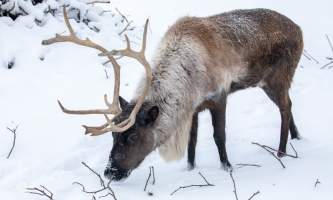Reindeer
Here we are at the reindeer habitat at the Alaska Wildlife Conservation Center.
Now before we get started, caribou and reindeer are the same species. In Alaska we refer to domesticated individuals in this group as reindeer while a common name used for their wild counterpart is caribou.
Domesticated reindeer tend to be smaller and stockier, whereas caribou in the wild will remain taller and slender to handle deep snows and constant movement. In the wild, short stocky animals do not fare well.
Reindeer (and therefore caribou) are also the only member of the deer family where both males and females will grow and shed their antlers.
Male reindeer (or caribou) will shed their rack, or antlers, after the fall or rut season. However, female caribou or reindeer will tend to carry their antlers throughout most of the winter, except if they are pregnant, in which case they will not shed their antlers until after giving birth. Fun Fact! For this reason, it is a little-known fact that all of Santa’s reindeer would have been female, as male reindeer or caribou would shed their antlers before December 25th. Interestingly enough, the herd at the AWCC is comprised of males, females, and steers. Steers are castrated males who tend to hold onto their antlers through the rutting season, so could technically compete for a spot-on Santa’s team.
Another interesting fact about the reindeer is their split hoof with two front toes and two smaller back toes or dewclaws. On hard terrain only their front two toes will contact the ground. In soft terrain, their front toes and smaller hind dewclaws will all come in contact with the ground, almost resembling that of a snowshoe.


